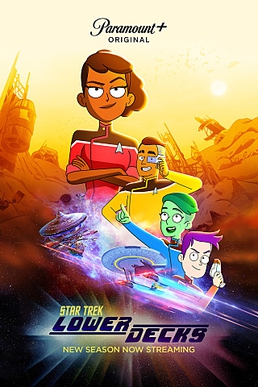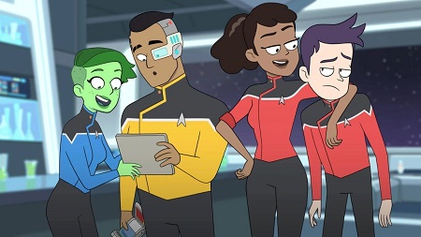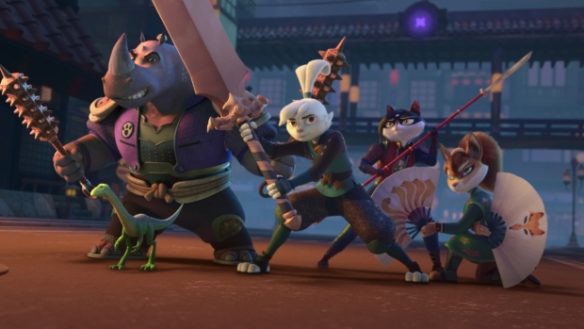
By Michaele Jordan: About a month ago, when I posted my first file here on File 770, I was delighted to discover that I was not alone in my fondness for Korean SF/F. (Thank you all!) I immediately started collecting material for a post about fox spirits. (I adore kitsune.) But I had barely started jotting down titles and checking the spelling of Korean actors’ names, when the Hugo ballots were announced.
Of course, everything in the world stopped, while I rushed to order books from the library and line up titles on Netflix, et alia. I particularly noted the anime titles. Several were familiar to me, but I have to admit I the Star Trek titles caught me off guard. I had never even heard of them. So, naturally, my sweetie and I curled up with some snacks, and tuned our electronic hearth to Paramount.
We started with Star Trek: Lower Decks. My first impression—and I mean immediately, like within about 3 frames—was that it looked an awful lot like Final Space. Final Space, alas, did not make it onto the Hugo ballot, although the third season aired on TBS between March and July in 2021. (I like to think it might have been a close race.) It was created by Olan Rogers who then developed it with David Sacks. Officially ShadowMachine in Los Angeles was responsible for the animation but they outsourced it to a Canadian studio, Jam-Filled, who used Toon Boon Harmony software and NASA space images.
If that sounds like more about the animation process than you really wanted to hear, my apologies. I spent an embarrassing amount of time on the research. Because, as I said above, Star Trek: Lower Decks really, really looked like it had been drawn by the same people. Except it wasn’t. The Star Trek show was animated by Titmouse. Creator Mike McMahan (who I hold in high esteem for his work on Rick and Morty and Solar Opposites) specifically wanted a look reminiscent of shows from the turn of the millennium.

You could even say the two shows had much in common. Both featured everyman heroes, goofy guys who, despite belonging to a glamorous interstellar military, didn’t have a lot going for them, except their good intentions. Yet they always managed to rise to their occasions, because—if nothing else—they believed in the dream. Unfortunately, Final Space did it a lot better than Star Trek: Lower Decks.
It’s not that I don’t love Star Trek. I’ve been watching it since 1966. (I missed the pilot—or rather, “Mantrap,” which was the first episode aired. I started with “Charlie X.”) My very first convention, back in 1973, was not an SF con, but the International Philadelphia Star Trek Convention. (My boyfriend took me. He had a press pass from the Doylestown Courier—his first job.) But Star Trek is almost as old as I am. It now has rules, and protocols, and boundaries. It is entrenched within its own mythology. You can sit down at any new Star Trek creation, confident that you know exactly what’s going to happen. That’s not what I came to SF/F looking for. Every frame in Final Space was unexpected. But Star Trek: Lower Decks was very predictable, not to mention snarky and sophomoric,
Mind you, I’ll still watch all the new shows, episodes and movies. For instance, we went straight on from Star Trek: Lower Decks to watch Star Trek: Prodigy. My hopes were high. For starters, instead of boring you with production details, I’ll just say it was computer animated. And it is beautiful. Be it aliens or alien worlds, star ships or kitchen tools, every image is gorgeous. If you are wondering why anime fans are, well, anime fans, go look at Star Trek: Prodigy. Anime fans want their field of vision to be filled with wonder. Star Trek: Prodigy does that.
The story starts out a bit darker than I expect of Star Trek. The protagonists are not just a rag-tag band of outcasts, but desperate orphans. They escape from a hellish world/culture by stealing a star ship from their gangster boss. They don’t even know that it’s a Federation ship—they barely know what the Federation is. The only flaw in their escape is that the gangster boss’s little daughter has snuck on board, hoping to stop them.

From there on, the story is a bit more traditional. It turns out that, since this is a Federation vessel—and a prototype, at that—it is equipped, not just with a holodeck, but a whole cast of Star Fleet holograms. Foremost among these is Captain Janeway, who appears immediately and designates them as cadets. So our damaged naïfs have someone to train them, protect them from themselves, and, most of all, to care about them. Let the adventures begin!
While I was roaming around, looking for Hugo nominated anime, I stumbled upon (or rather bumped into the widely advertised) Samurai Rabbit. This is not on the Hugo ballot, for the simple reason that it is brand new. But I have high hopes of seeing it on next year’s list of nominees. It is based on the much-admired Dark Horse comic, Usagi Yojimbo, which relates the adventures of Miyamoto Usagi. (Usagi is Japanese for rabbit.) The character is a light-hearted reimagining of the great Japanese ‘sword saint’, Miyamoto Musashi, (1584-1645).

I confess that I have never followed the comic. But I am, due to a complicated series of odd chances, in possession of the first issue. I am told it is valuable, and have never dared take it out of its plastic wrapper. So I cannot say how closely the anime follows the comic—I am told there are some significant changes. I can say that, aside from a more three-dimensional imagery, the anime looks very much like the comic.
And it is utterly delightful! The imagery—the sentient animals, the period costumes, the temples, the flying boats, the magic!—is awesome! (Although my husband complains with every episode that the fox should not have her tail growing out of the back of her head.) There is lots of action, and lots of silliness. Please, friends, give it a watch (it’s easy to find—it’s on Netflix) and consider nominating it for next year.
Michaele Jordan was born in LA, educated in New York, and lives in Cincinnati. She’s worked at a kennel, a Hebrew School and AT&T. Now she writes, supervised by a long-suffering husband and two domineering cats. She has numerous stories scattered around the web, and her novel Mirror Maze is available on Amazon. Her website, www.michaelejordan.com, is undergoing reconstruction, but just grab a hard hat, and come on in.
